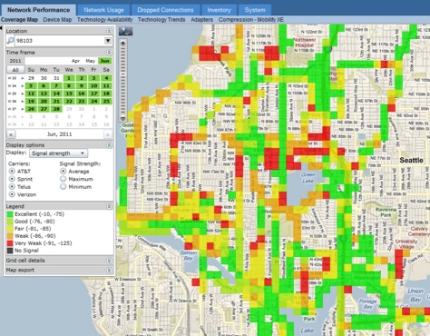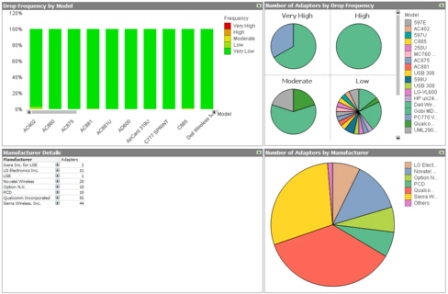Back in 2003, our friends at Intel Capital gave us a call to let us know about a company they had just invested in - a small, Seattle-based mobile VPN vendor by the name of NetMotion Wireless. NetMotion was competing in a space that, at the time, was just coming into its own and had a number of vendors competing in the same mobile VPN space. Mobile VPNs - NetMotion's has long been called Mobility XE - offer unique wireless capabilities though it is outside the scope of our article to go into them here.
Suffice it to say that mobile VPNs were - and remain - critical to specific mobile markets, and especially to mobile field service workers - including field-based government agencies such as police departments - who need to use secure, mobile-enabled laptops rather than mobile devices such as smartphones. Recently we wrote about Sierra Wireless - another of our CTIA 2013 Gems which, back in those days, was one of the few companies that delivered wireless communications air cards to mobile-enable those laptops that mobile VPNs then made secure and ensured ongoing connectivity.
Mobility XE is now, a decade after our first encounter with NetMotion, the most widely deployed mobile VPN in the market. The company has 2,000 customers in the enterprise, government, utility, healthcare, public safety and insurance verticals, among others. What is interesting to note is that a decade later, and in spite of the growing availability of advanced LTE wireless networks, most of NetMotion's customers - as well as the carriers that NetMotion partners with - still run into all sorts of wireless connectivity issues - from low bandwidth to intermittent bandwidth to no connectivity at all to all sorts of other connectivity anomalies.
What we mean by this of course is that the wireless communications breakdown and mobile workers out in the field are left unconnected. It is a virtue of mobile VPNs that they are able to easily reconnect when the wireless network is rediscovered - typically without the user knowing they've ever been disconnected. Mobile VPNs retain a user's login state and smooth out intermittent connections. They are also easily able to switch between and hand off across networks and Wi-Fi systems in the same manner.
Sometimes, however, the lack of wireless network availability is such that even the mobile VPN isn't able to keep workers as fully productive as they need to be. If there is no network access for either a prolonged period of time or if it is always the case in specific geographic locations, a Mobile VPN won't be able to do its job effectively or efficiently.
All businesses that deploy mobile field service personnel must invest heavily in mobile services and hardware to ensure reliable connects between their mobile workers and the mission-critical applications and information they need to use. This happens primarily over the public cellular networks. When difficult connectivity problems arise and cannot immediately be solved it puts a great deal of pressure on organizations to gain visibility into their deployments so they can protect investments, keep costs low and ensure the reliability and security of mobile technologies for employees.
Of course the very first thing NetMotion's customers do in such cases is to blame the wireless carriers. It is a logical conclusion to draw, but the problem is that in far more cases than not, it isn't the wireless carrier's network that is the problem - though there has typically been no way to either disprove this or to otherwise track down the real causes of losing connectivity. At least not until Locality showed up.
Locality Delivers on the Real Underlying Connection Issues
It has been with the goal of truly solving where and why serious wireless connectivity issues exist that NetMotion created Locality, its cellular network performance management platform. Locality fulfills the critical need of uncovering serious network issues by delivering real-time cellular deployment insight, and powerful reporting and management tools. It was with the goal of getting the details locked down on Locality that we spent some quality time catching up with Andy Willett, NetMotion's SVP for business development and marketing, at CTIA where he provided us with a solid overview of the product and the reasons for its existence.
Locality is installed on a mobile user’s device and then immediately begins to gather data about both the user's connection and the device. The platform supports Android, iPhone and full Windows 8 devices and delivers advanced LTE network management as well.
What is critical here, Andy points out, is that "data that is collected includes numerous key data points that include signal quality, wireless technology type (2G, 3G, 4G), specific location, user identification (who’s logged on), what GPS device is being used, aircard information and application usage. When you have all of these data points to analyze - and keep in mind that we are talking here not just about a single individual - though sometimes this is the case - but about numerous people and significantly aggregated data in some cases as well. It's amazing what you will learn."
This gathered and aggregated information is then presented to IT staff visually in maps and reports. IT teams can then accurately ensure deployment performance by detailing how well mobile applications, technologies and networks are working. Let's examine the following typical network performance map - but keep in mind that many views are possible - the one shown below is simply one instant of these numerous possible views into the aggregated data.
(Click on image to enlarge)

Connectivity issues can be addressed quickly, and businesses can determine such things as where issues are centered, as well as being able to track down what is causing any given issue. Problems can be due to bad aircards, bad antennas and/or bad antenna placements, software anomalies and so forth.
Sometimes it is indeed the carrier's fault - but with Locality both the wireless carrier and their business customers end up with hard data they can both work with - there are no longer any mysterious issues that either the business or the carrier have to deal with. It gives both equal footing to quickly resolve problems, develop workarounds, and re-negotiate business terms based on much easier to determine SLAs.
The view shown in the image below demonstrates how Locality provides information on numerous potential wireless communications factors.
(Click on image to enlarge)

Traditional network management tools aren’t able to provide insight into cellular networks. Locality, as the image above shows, was developed specifically to meet this gap. The software provides detailed reports and analytics on device, application, modem, and cellular network operation to help organizations troubleshoot connectivity issues, increase productivity of their mobile workers, and to make informed business decisions - often times working together with their wireless carriers, based on empirical data.
Given our long-term coverage of this space, we've long been aware of these connectivity issues. It is very encouraging to see NetMotion grab the bull by the horns and deliver a real solution to a critical need. That's why we've spotlighted them as another of our CTIA 2013 Gems.
Editor in Chief Rich Tehrani also conducted a video interview at CTIA 2013 with Andy.
Other CTIA 2013 Gem articles include the following:
Edited by
Alisen Downey  QUICK LINKS
QUICK LINKS